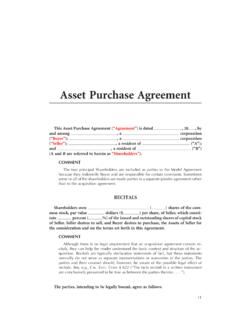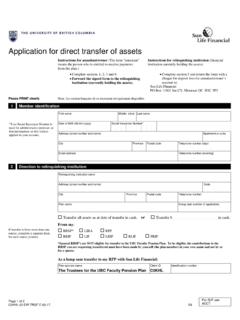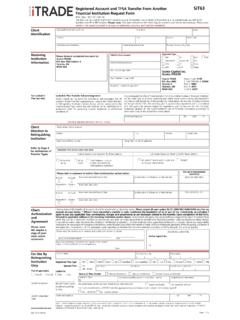Transcription of 2. Sale and Transfer of Assets; Closing - jimstclair.com
1 2. Sale and Transfer of Assets; Closing ASSETS TO BE SOLD. Upon the terms and subject to the conditions set forth in this Agreement, at the Closing , but effective as of the Effective Time, Seller shall sell, convey, assign, Transfer and deliver to Buyer, and Buyer shall purchase and acquire from Seller, free and clear of any Encumbrances other than Permitted Encumbrances, all of Seller's right, title and interest in and to all of Seller's property and assets, real, personal or mixed, tangible and intangible, of every kind and description, wherever located, including the following (but excluding the Excluded Assets): (a) all Real Property, including the Real Property described in Parts and ;. (b) all Tangible Personal Property, including those items described in Part (b).
2 (c) all Inventories;. (d) all Accounts Receivable;. (e) all Seller Contracts, including those listed in Part (a), and all outstanding offers or solicitations made by or to Seller to enter into any Contract;. (f) all Governmental Authorizations and all pending applications therefor or re- newals thereof, in each case to the extent transferable to Buyer, including those listed in Part (b);. (g) all data and Records related to the operations of Seller, including client and customer lists and Records, referral sources, research and development reports and Records, production reports and Records, service and warranty Records, equipment logs, operating guides and manuals, financial and accounting Re- cords, creative materials, advertising materials, promotional materials, studies, reports, correspondence and other similar documents and Records and, subject to Legal Requirements, copies of all personnel Records and other Records de- scribed in Section (g).
3 (h) all of the intangible rights and property of Seller, including Intellectual Property Assets, going concern value, goodwill, telephone, telecopy and e-mail addresses and listings and those items listed in Parts (d), (e), (f) and (h);. 41. 42 Model asset Purchase Agreement (i) all insurance benefits, including rights and proceeds, arising from or relating to the Assets or the Assumed Liabilities prior to the Effective Time, unless expended in accordance with this Agreement;. (j) all claims of Seller against third parties relating to the Assets, whether choate or inchoate, known or unknown, contingent or noncontingent, including all such claims listed in Part (j); and (k) all rights of Seller relating to deposits and prepaid expenses, claims for refunds and rights to offset in respect thereof that are not listed in Part (d) and that are not excluded under Section (h).
4 All of the property and assets to be transferred to Buyer hereunder are herein referred to collectively as the Assets.''. Notwithstanding the foregoing, the Transfer of the Assets pursuant to this Agree- ment shall not include the assumption of any Liability related to the Assets unless Buyer expressly assumes that Liability pursuant to Section (a). COMMENT. The identities of the specific assets to be transferred and the liabilities to be assumed (see Section ) are the heart of an asset purchase transaction. The acquisition agree- ment and the disclosure letter should identify, in detail, those assets the buyer will acquire. The mechanism used for this identification will depend in part upon the amount of detail the parties desire, the nature of the assets involved and the status of the buyer's due diligence at the time the acquisition agreement is finalized.
5 The iden- tification could be guided by a consideration of which assets listed on the balance sheet the buyer intends to purchase. The asset description could also be used as part of the buyer's due diligence investigation or to confirm that investigation. To this end, the buyer could give the seller an exhaustive list of assets and leave it to the seller to tailor the list to fit the assets the seller has and considers part of the assets to be sold. The Model Agreement initially describes the assets to be acquired in a general way, followed by a categorization into the groupings listed in Section This general description is further supplemented, to the extent appropriate, by reference to Parts of the Disclosure Letter to list or describe particular items within certain groupings.
6 This method works well when the buyer's due diligence is well under way at the time the acquisition agreement is finalized and allows the parties to specify, for example, which particular contracts buyer will acquire. Alternatively, the parties might omit any specific identification or description and describe the acquired assets only by categorizing them into general groupings. Al- though the parties should always pay close attention to the definition of Excluded Assets, the mechanism by which the assets that are excluded from the transaction are described assumes even greater significance when the acquired assets are described in only a general way. The interplay between the section that lists acquired assets and the section that lists the excluded assets also requires close attention.
7 The Model Agreement specifically provides that the listing of Excluded Assets set forth in Section takes priority over the listing of Assets set forth in Section This priority is established both by the parenthetical at the end of the introductory paragraph of Section and the language at the beginning of Section As a result, particular care needs to be given to the listing of excluded assets because that list will control in any situation in which a particular asset could be both an asset and an excluded asset . Section 43. The categories of assets in Section are described using a combination of defined terms and specific descriptions. This approach represents a blend of two extremes: (a) defining all terms elsewhere and using only the defined terms in Section and (b) placing the complete description of all assets in Section with the definitions at the end of each category.
8 In the Model Agreement, defined terms are used to cover categories of assets where that defined term is used elsewhere in the Model Agreement (for example, in the representations). Reference is made to the definitions of the various defined terms used in Section and the related Comments for further description of the scope of those terms. If no defined term is needed elsewhere in the Model Agree- ment, a specific description of the category of assets is used. Where defined terms are used, the definitions need to be carefully drafted to Transfer only the assets intended and to ensure that the defined terms are used consistently throughout the Agreement. For example, Buyer is purchasing all of Seller's Tangible Personal Property,'' a term that includes personal property owned or leased by Seller (see Section (b)).
9 There- fore, because Buyer is purchasing all leased personal property, the associated lease contracts should be listed on the Part of the Disclosure Letter referred to in Section (e), should not be listed on Exhibit (f ), which identifies Excluded Assets and should be listed on the Part of the Disclosure Letter referred to in Section (a)(v). Whether a defined term or a specific description is utilized, the buyer can reduce the risk that an unlisted item will be excluded from the acquired assets by using such language as including.'' Although Section (a)(vii) expressly recognizes that the word including'' does not limit the preceding words or terms, the rule of ejusdem generis has been applied to construe the meaning of a broad phrase to include only matters that are of a nature similar to those specifically described.
10 See the Comment to Section If there are specific assets that are of significant importance to the buyer, the buyer may want to specifically list those assets instead of relying on an introductory catch- all'' phrase or any including'' clause that lists assets of a similar type. For example, if a seller owns subsidiaries, the buyer may want to specifically identify stock of the subsidiaries as assets in Section Similarly, if the seller owns or has access to certain business development assets, such as luxury boxes, event tickets or the like, the buyer may want to specifically identify those assets as well. Under Section (i), all insurance benefits are transferred to Buyer unless expended in accordance with the terms of the Model Agreement.




